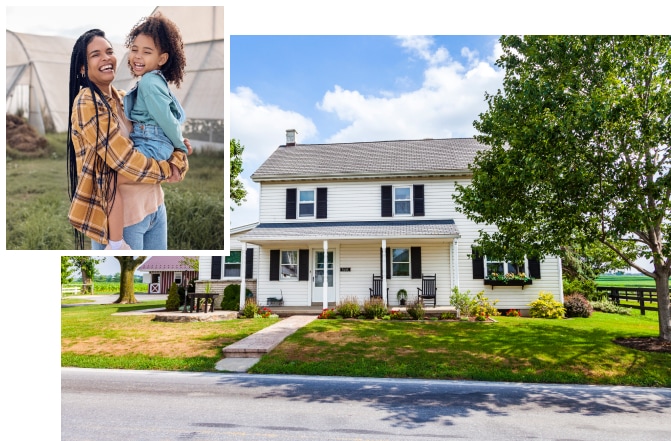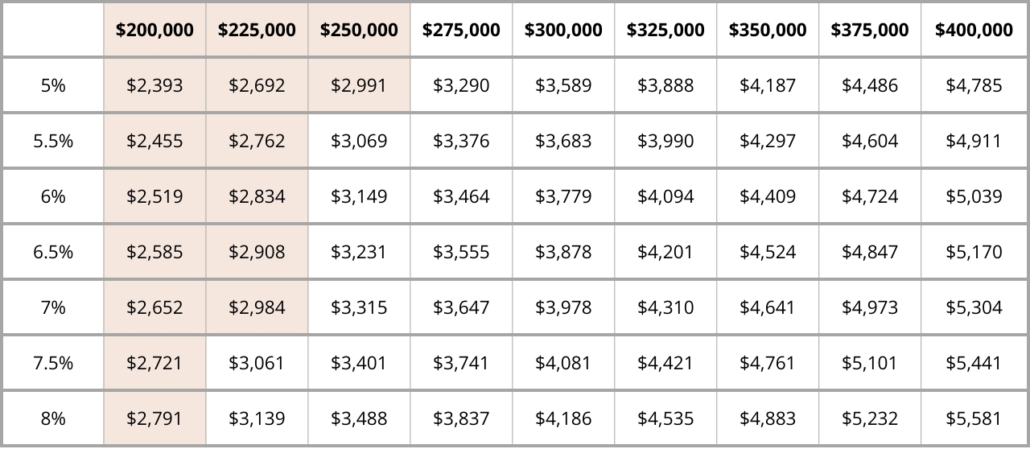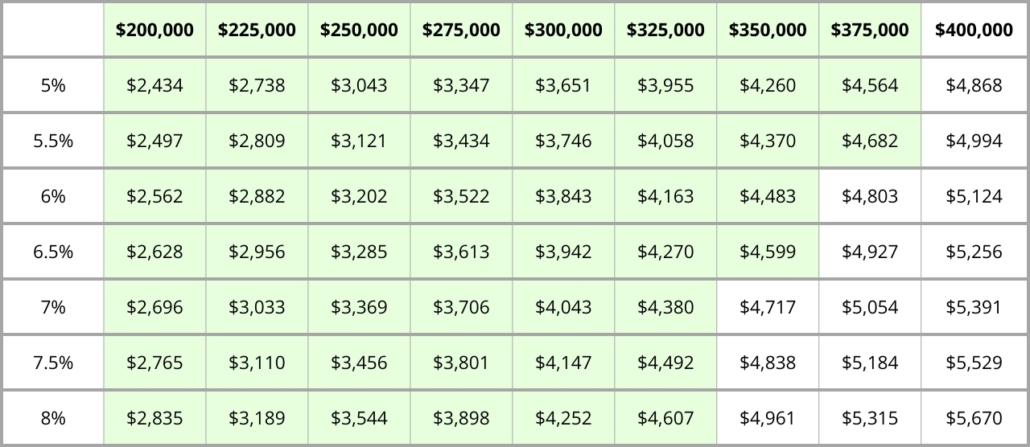You are less than 60 seconds away from your quote.
Resume from where you left off. No obligations.
USDA mortgage loans are a zero down payment option that allows eligible homebuyers in designated rural areas to buy with 0% down.

A USDA mortgage loan is a zero down payment mortgage option designed to make homeownership more accessible particularly in rural areas.
A USDA mortgage loan is a zero down payment option that allows eligible borrowers to finance 100% of the home’s price (meaning, a 0% down payment is required). Therefore, if you’re purchasing a home for $300,000, your down payment can be as low as$0. You may still need to provide some or all of the purchase’s closing costs, although closing costs can be financed in specific cases, too. Compared to other loan programs, this option helps to make homeownership more accessible to individuals who may not have substantial savings but are otherwise financially responsible and capable of affording a mortgage.
To be eligible for the USDA mortgage loan, there are a few requirements to consider. First, this program is specifically designed for homebuyers who plan to occupy the home as their primary residence. Additionally, the property must be located in a USDA-designated rural area.
Your income must also meet certain guidelines based on the area median income (AMI) in your location. The specific income limits may vary depending on where you plan to purchase your home. You can check the most recent income limits here.
Finally, you do not need to be a first-time homebuyer to qualify for a USDA mortgage loan! But, if you currently own another property, additional requirements and parameters do apply.
The USDA loan program guidelines are designed to help borrowers living and working in rural areas achieve homeownership. The program allows:
Remember, these are the basic eligibility requirements. Contact JVM Lending to speak with a mortgage expert about additional requirements or variations on these basic eligibility criteria.
Understanding the role of credit scores and loan limits in the USDA loan process is crucial for prospective homebuyers. Here’s what you need to know:
Credit scores play a significant role in the USDA loan approval process. In order to qualify for a USDA loan, the lower-middle credit score across all borrowers must be at least 640.
This score is determined by a doing a credit check in which all 3 credit bureaus report a credit score back to the lender. The middle score is then the “qualifying” score used to determine eligibility.
If there are multiple borrowers on a loan, the middle scores are compared for each borrower, and the lowest one from all applicants must be used to determine program eligibility.
If your scores are below 640, there may be other loan programs, such as FHA Financing, that could be a suitable alternative. These options will require a larger 3.5% minimum down payment, however.
Unlike other government backed mortgage programs, USDA loans set maximum income limits based on family size based on the area’s median income in which the subject property is located.
Households of 1-4 have lower income limits than households of 5-8. Beyond 8 people, the maximum allowable income grows by 8% for each 4-person increment.
At the lowest end of the spectrum, the maximum qualifying income is $110,650 for a 1-4 person household size, and $146,050 for a 5-8 person household size.
At the highest end of the spectrum, the maximum qualifying income is $238,200 for a 1-4 person household and $314,400 for a 5-8 person household.
In practice, most eligible USDA-designated rural areas fall in areas with lower income limits.
These income limits, combined with the strict debt-to-income housing ratio allowance of 29% mean USDA loans often do not give buyers as much purchasing power when compared with other loan solutions. This is because not only must borrowers earn a small enough income to qualify, they must earn a large enough income to keep their debt-to-income ratio within qualifying range.
Here is an example of what a household of 4 earning $110,000/yr could qualify for with a USDA loan compared to an FHA loan.
This assumes a property tax rate of 1.5% and homeowner’s insurance of .5% – this example is purely for demonstrative purposes only.


View mortgage rates for
April 28, 2024
Closing costs are an essential part of the homebuying process that every prospective homeowner should understand. These are fees and expenses that are paid at the end of the real estate transaction and can include a variety of costs such as loan origination fees, appraisal fees, title insurance, and more.
For USDA loans, closing costs can vary based on the lender and the specifics of the home purchase. However, they typically range from 1% to 3% of the loan amount. Here’s what you need to know:
One of the benefits of USDA loans is the ability to finance closing costs. If the home appraises for more than the sales price, closing costs can be included in the loan up to the appraised value. Even if the home appraises at the sales price, the Upfront Guarantee Fee can still be financed by the loan. This can significantly reduce the amount of money needed at closing.
However, it’s important to remember that financing closing costs means you’ll be paying interest on them over the life of the loan, which can add to the total cost of your mortgage.
In some cases, the seller may agree to pay a portion of the closing costs, also known as seller credits. This can be a helpful way to reduce the amount of money needed at closing. However, seller concessions are subject to negotiation and are not always available; additionally, federal lending law caps the maximum amount of credits allowed on each transaction.
With USDA financing, sellers can credit up to 6% of the purchase price towards closing costs.
Like any financial product, USDA mortgage loans come with their own set of advantages and disadvantages. It’s important to weigh these pros and cons carefully to determine if this type of loan is the right fit for your financial situation and homeownership goals.
One of the most significant benefits of USDA loans is the zero down payment requirement. This feature makes homeownership more accessible, especially for first-time homebuyers or those with limited savings.
USDA loans typically offer lower interest rates compared to conventional loans, which can result in significant savings over the life of the loan.
USDA loans are more forgiving when it comes to credit scores, making them an excellent option for borrowers with less-than-perfect credit.
USDA loans are only available for properties located in USDA-designated rural areas. This can limit your home buying options if you prefer to live in a more urban or suburban setting.
To qualify for a USDA loan, your household income must not exceed certain limits, which are based on the median income in the area in which the desired property is located. This typically results in very reduced purchasing power.
While USDA loans do not require a down payment, they do require an upfront guarantee fee and an annual fee, similar to mortgage insurance. These fees are used to protect the lender in case of default.
In addition to the income restrictions, your purchasing power is further reduced with USDA financing as it requires your housing expense (including taxes, insurance, and guarantee fees) to be below 29%. This may create a sizeable gap between your purchasing power and the home prices in your desired area.
Unlock the door to homeownership with the USDA mortgage loan. By allowing you to finance 100% of the home’s price, this program empowers homebuyers to achieve their dreams of owning a home. Before diving into the homebuying process, it’s important to research and explore your options thoroughly.
USDA loans are an attractive choice, but it’s essential to consider your personal circumstances, financial goals, and eligibility requirements to make an informed decision. By partnering with a trusted mortgage lender like JVM Lending, you can navigate the homebuying journey with confidence.
If you’d like to get in touch with a JVM expert directly, call (855) 855-4491 or email us at [email protected].

Resume from where you left off. No obligations.